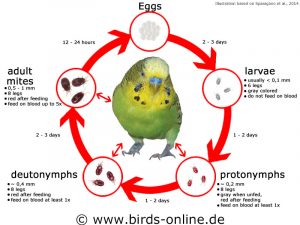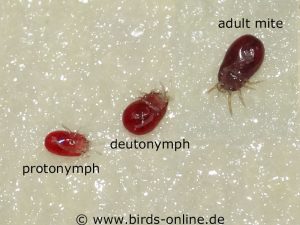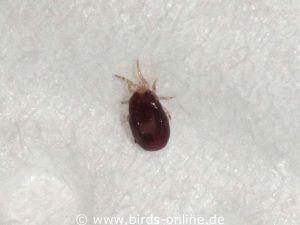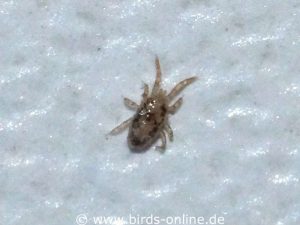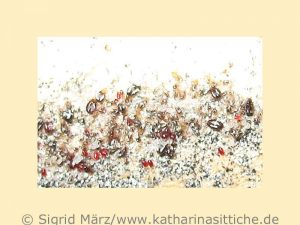- >>
- Birds Online – English
- >>
- Health and diseases
- >>
- Parasitic infestations
- >>
- Blood-feeding mites
Blood-feeding mites (Red mite and Northern fowl mite)
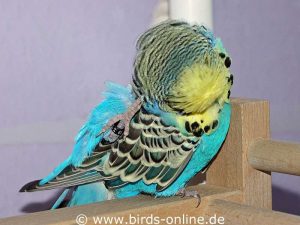
Parasites that live on their hosts’ bodies are called ectoparasites. They include the bloodsucking mites found on some birds. Let’s get this straight: Mites are not insects, but arachnids. They need air to breathe, which is why they settle on the birds’ body surface. In pet birds, just as in ornamental and farm poultry, there are mainly two types of blood-feeding mites showing different ways of life and behavior. This chapter tells you more about these tiny parasites and describes how you can detect and get rid of them in case your birds are affected.
Something basic should be explained in advance. Very often, unfortunately, laymen “diagnose” mites where there are none. The fact that a bird scratches himself/herself frequently is not necessarily due to a mite infestation. In many cases, a harmless molt is behind it or the bird suffers from itching, which can be caused by eczema, for example. It is therefore important to closely watch the animals in case of suspicion and to present them to an avian vet so that he or she can make a reliable diagnosis. Even if you “only” go to the vet as a precaution because of a molt, you have certainty later and do not worry constantly whether the birds may suffer from an infestation with mites or other parasites or not. Furthermore, by knowing the behavior of these parasites, you can often find out yourself if there is a need to worry.
Red mite (Dermanyssus gallinae)
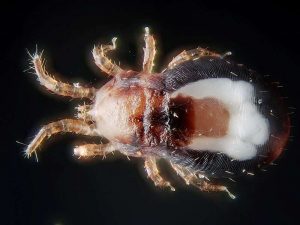
Red mites are between 0.5 and 1 millimeter in size. Male individuals are usually slightly smaller than females. These tiny parasites are not insects, but arachnids. This can be recognized by the fact that they have eight legs in later larval stages and as adults. Insects, on the other hand, have only six legs as adult individuals.
The Red mite has a special way of life: At night, these animals creep over the birds’ bodies and feed on their blood. During the day, the parasites hide in the cracks of the cage/aviary, the birds’ immediate surroundings, or in small crevices in the wood of perches or in roosting and nesting boxes. That means they are usually not found on the birds during the daytime. If blood-feeding mites do appear on birds during the day, they are most likely Northern fowl mites. Usually, Red mite reproduction takes place in daytime hiding places where they like to stay in groups. This sociable behavior allows the mites to find partners for mating. Sometimes, however, they mate while the females are feeding on blood at night.
The life cycle of the Red mite is extremely short: From egg to larvae, development takes only two to three days at temperatures around 20 °C. If the temperatures are around 9 °C to 15 °C, it takes five days for the larvae to develop from the eggs. This is followed by further life stages – here comes a brief chronological overview according to Sparagano et al., 2014, referring to temperatures around 20 °C:
- Egg-laying
- The six-legged larvae hatch after 2 to 3 days; they are usually smaller than 0.1 mm and gray; they do not yet feed on blood
- After another one to two days, the larvae molt and become protonymphs; they are about 0.2 mm long or slightly larger and gray when fasting; after the first blood meal they are red; they have eight legs from now on
- One to two days later the protonymphs molt and become deutonymphs with a body length of about 0.4 mm; they continue to feed on blood
- After two to three days another molt takes place, the mites are now adults and take up to 5 blood meals in the following days; when they are fasting they are gray-brown, after feeding on blood they are dark red; 12 to 24 hours after feeding the females can lay eggs
How do red mites find their way to birds?
Red mites get into the house, for example, with natural branches or other wood, for example, second-hand purchased nest boxes. Only very rarely they succeed in traveling to a new home on a bird, which is because they are nocturnal and most birds tend to move into a new home during the day.
How do you recognize an infestation with these parasites?
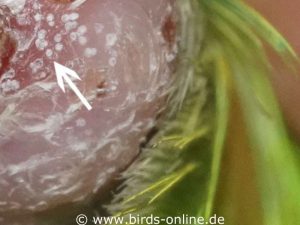
A bird plagued by red mites is extremely restless at night, cannot get to sleep, scratches herself/himself frequently, and shakes her/his feathers a lot. One way to tell if a bird is sleeping poorly at night is by the distribution of the droppings on the ground in the cage. But you can also hear it if you’re not too deeply asleep yourself because a bird troubled by blood-feeding mites will often climb around in the cage to avoid the parasites. Sometimes, a mite-plagued bird will even fly around the cage in a panic at night. During the day, on the other hand, the animal sleeps a lot, appears dull and tired; besides, the bird’s skin itches due to the punctures caused by the mites. And your feathered friend scratches himself/herself more frequently than average. You can try and use a magnifying glass to spot tiny round puncture marks in the bird’s skin – these are the regions that have been bitten by the mites during the night.
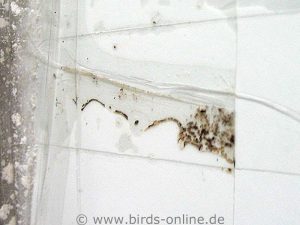
To detect red mites, it is best to hang a white cloth over the cage in the evening in case of suspicion and look at it during the night. You can try to see if there are small red to black-red colored “dots” wandering around on this cloth. Another method of detecting the red mites is to line the corners of the cage or aviary with self-adhesive clear film. The film must be applied in such a way that a cavity is formed which is accessible from the side. Also, the birds must not be able to touch the adhesive side of the film under any circumstances! After feeding on blood, the mites return to their hiding places in the early morning hours and then some of them will most probably creep into the small cavity under the self-adhesive film. They stick to it and thus can be seen as tiny red dots. Dead mites usually quickly change color and turn dark gray or black.
How to get rid of Red mites
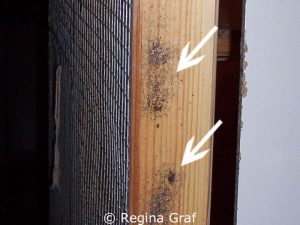
It is not without reason that Red mites belong to those parasites most feared by bird owners. Because it is not always easy to eliminate them. The birds cannot be treated with medications that kill the mites as in the case of other parasites. It is necessary to make sure you kill each and every Red mite in your home. The best strategy is to target them in their daytime hiding places. In doing so, not a single egg or mite should be left, otherwise, the parasites may reappear later. Thus, it is important to completely rid the cage or aviary, accessories, and the environment of your birds, including furniture, of mites of all age stages.
It is advisable to immediately move affected birds to a spare cage after discovering an infestation of red mites, where new bowls, perches, swings, and new toys should be placed. This additional cage should not be placed in the same location in your home where the mite-infested cage was previously set. The environment of the old cage is very likely to be infested with mites as well, and you will have to eradicate them first before the birds can live in their old place again.
Clean and disinfect everything that your birds have come to touch with. Especially the dishes and the cage should be treated with hot water and a brush. It is advisable to rigorously throw away the perches and swings, and if possible, immediately take the garbage bag out of the house. You also need to apply a remedy against the mites, which you can get from the vet; he will also tell you how to dose it. Several preparations are either poison-based or kill the mites non-toxic and mechanically.
Biological control of the Red mite

In nature, the major principle is: eat and be eaten. Red mites are also subject to this elementary law. Evolution has generated enemies that can decimate red mites even in houses. These are predatory mites that do not harm birds or humans and only prey on blood-feeding mites. In Germany, the mite species Androlaelaps casalis is sold as natural predators against Red mites, see below.
The application of these predatory mites is especially recommended if the birds are housed in a wooden aviary or live in a house where there is a lot of wooden furniture. Hardly any bird owner is likely to be enthusiastic about the idea of throwing away and replacing all wood – for example, parquet flooring, shelves, or cabinets. By the way, the predatory mites die after a certain time, because when they have eaten all the blood-feeding mites, they no longer find food and starve to death. So there is no need to act against the predatory mites later as well.
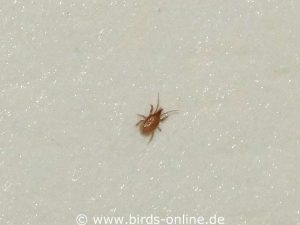
The predatory mites available in Germany for controlling the red mite are scientifically called Androlaelaps casalis. Originally, this mite species is native to virtually the entire northern hemisphere. In nature, for example, these animals can often be found in bees’ nests. They are therefore referred to as Bee mites. Androlaelaps casalis is specialized in preying on and feeding on other mite species as well as on small invertebrates. With their special mouthparts, the tiny arachnids easily manage to suck the prey empty. However, because Bee mites cannot pierce the skin of humans and birds, the species is ideally suited for combating the Red mite without harming anyone else.
Attention: After Bee mites have been feeding on Red mites who had been drinking blood before, the predatory mites might turn red themselves. This doesn’t mean they have been sucking blood from a bird. Instead, they swallowed the blood from the Red mites.
Mechanical-biological control of the Red mite
Powder based on diatomaceous earth mechanically damages the Red mites: As the mites walk through the very fine powder, tiny crystals become stuck to their joints. As the mites run, the crystals rub and the body shell becomes leaky. This causes the mites to dry out and finally die. So they can be killed without using any predatory mites or poison.
Often confused in Europe: Red velvet mite (Trombidium holosericeum)
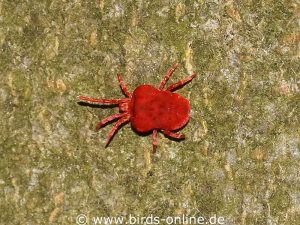
Many bird owners from Central Europe who bring branches or green food from outside into the house encounter a species that is often mistaken for the Red mite because of its red coloration: the Red velvet mite. This arachnid, up to 4 millimeters in size, is widespread and common in Central Europe. These mites feed on insect eggs and small animals living on the ground. They would not bite birds or even humans. The larvae of the Red velvet mite live on insects such as butterflies or grasshoppers. Thus, in general, they’re no threat to pet birds either.
If a red velvet mite is accidentally brought into the house with branches, the animal should be caught and brought back outside. There, the eight-legged predator can then continue to search for and prey on insects.
Northern fowl mite (Ornithonyssus sylviarum)
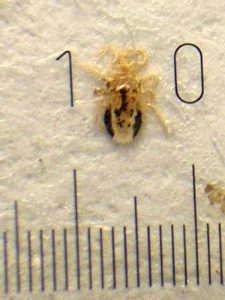
With a body size of only 0.8 millimeters, the Northern fowl mite is barely visible with the naked eye. Like the Red mite, it belongs to the arachnids; it has four pairs of legs and a relatively narrow, oval or pear-shaped body. Once it has fed on blood, the shape changes and the mite’s body seems to be almost round. Northern fowl mites are yellowish to brownish before feeding on blood. If they have ingested blood, they appear dark brown to black.
Unlike the Red mite, this ectoparasite can also be found on birds during the day and the mites can be seen wandering around as tiny dark spots on the birds. Infested birds scratch themselves very often or even pull out their feathers to get relief from the itching. Therefore, after a certain time, many affected birds show bald patches on their bodies. They also sleep restlessly and appear dull overall. In particularly severe cases, anemia can occur.
Because the Northern fowl mite mainly affects wild birds, it is rarely observed in pet birds kept indoors. However, it is possible to bring these parasites into the house, for example, when birds from an outdoor aviary move in or when branches are taken from outdoors. Besides, there is a risk of introducing the parasites if a pet bird is taken in that has previously escaped from someone and was picked up outside.
To get rid of the Northern fowl mite, a different treatment strategy is needed than for the Red mite. Either the birds are treated with insecticides, for example with certain powders or sprays. Alternatively, they can be treated with a contact poison such as products containing Ivermectin. These agents should only be used after discussing this step with an avian vet. Powders based on diatomaceous earth can additionally be used.
To be on the safe side, not only the birds should be treated, but also the cage/aviary, the accessories, and the surrounding area should be disinfected or cleaned as described above for the Red mite. Your vet can also provide you with advice on this.
Danger for humans
Red mites and Northern fowl mites can also attack humans under certain circumstances. If your birds suffer from an infestation of these mites and you notice itchy skin rashes, the parasites may have spread not only near the birdcage or aviary but also in the vicinity of your bed or sofa. You can avoid an invasion of these parasites in your home in a particularly sustainable way if you act immediately at the first signs of a mite infestation and take consistent action against the tiny blood-suckers.

